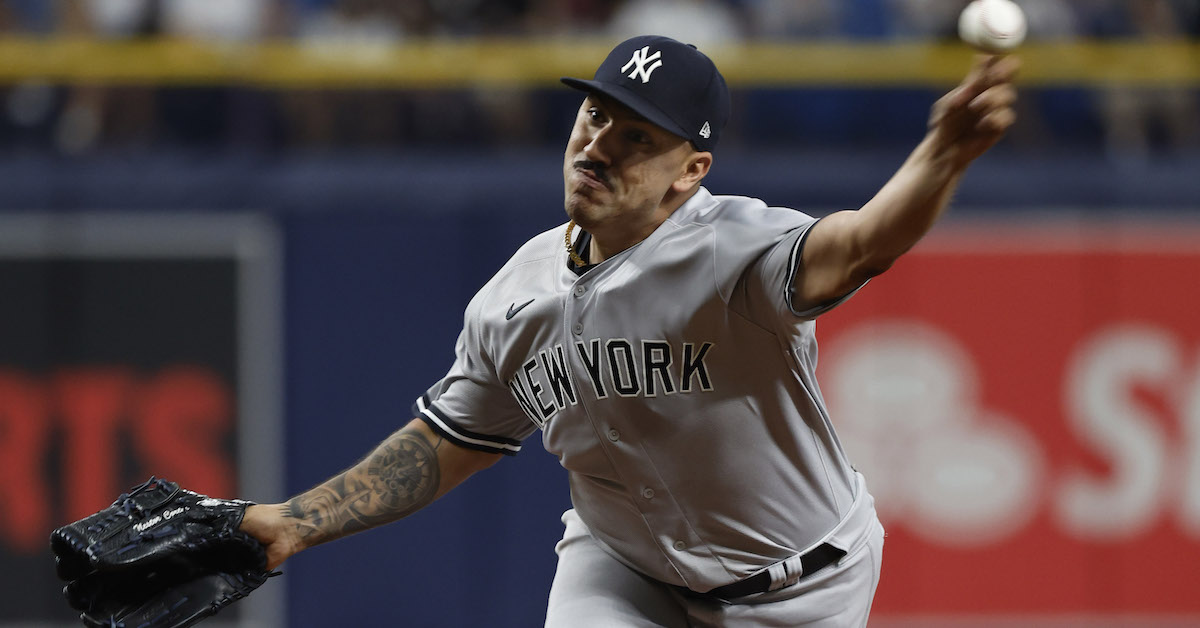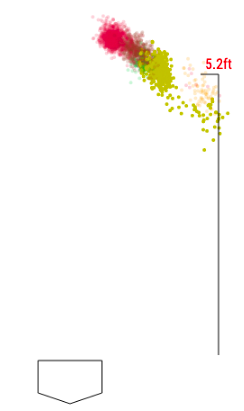Arm Angle Analysis: The Pros and Cons of a Sidearm Shift

Originally a 36th-round pick in the 2013 draft by the Yankees, Nestor Cortes spent time with the Orioles and Mariners before returning to the Bronx and putting it all together toward the end of the 2021 season, his age-26 year. Even upon breaking out, he was dubbed an “everyman” by the New York Post, overlooked by scouts because he didn’t stand as tall as other hurlers and because he lacked overpowering velocity. Yet in 2022, Cortes mowed hitters down to the tune of a 2.44 ERA and 20.3% K-BB rate. Far from an everyman, he was a standout athlete.
The southpaw’s breakout wasn’t a product of a mid-career growth spurt. If anything, his emergence came in spite of his 5-foot-11 height; his 159 ERA+ in 2022 tied him for the 27th-best mark among sub-six-foot hurlers since the Live Ball era began in 1920. Rather, the most concrete reasons for Cortes’ improvements include a velocity jump in both 2021 and ’22 (though his velo is still below average) and the introduction of a cutter paired with a revamped slider. Yet despite the ambiguous impact it has on his game, what perhaps differentiates Cortes the most from other pitchers is his approach on the mound, including but not limited to his varying arm angles.
The hurler’s drop-down moves have been the subject of many an article, including Lucas Kelly’s piece on this very site. The discussion on arm angles more broadly, however, has been rather muted, save for Logan Mottley’s (now of Fanatics, previously of the Texas Rangers) post describing how they can be calculated from Statcast data and Ben Palmer’s piece for Pitcher List digging into the Mottley data.
Even in these articles, there is no mention of how stature might play into the effectiveness of certain arm angles. Instead, there seems to be an implicit assumption that if one arm slot proved more effective on average (which, to be fair, no one has concluded), it should automatically be utilized more, without regard for what might feel most natural for a given pitcher. What would happen if we tried to convert more pitchers to a sidearm slot, or at least push them to vary their arm slots a la Cortes? Using Mottley’s calculations, I took a crack at these questions myself.
Why specifically a “sidearm” slot? For one, that’s where Cortes drops down to. But also, I found that for the 473 hurlers who threw at least 500 pitches last year, more obtuse arm angles (i.e., larger angles created by the shoulder at release, moving away from overhand and toward submarine) led to significantly higher called-strike rates. Specifically, for every one-degree increase in arm angle, pitchers on average had called-strike rates 0.02% higher. As Kelly speculated in his piece, it’s possible that this is because the rarity of a sidearm look sometimes gives the batter pause and they can only watch as the pitch zips into the strike zone. In other words, there may not be anything intrinsic in the sidearm pitch that lends itself to a higher rate of called strikes; if more hurlers were to begin throwing that way, batters might get used to it and freeze less frequently.
The impact on called-strike rate was the only consistent change based on average arm angle. But even within that finding, pitchers who vary their arm slot tend to have higher average arm angles than pure overhanders or three-quarter slotters, so they could be picking up some of the effect too; maybe it isn’t that throwing sidearm nets more called strikes, but that mixing things up by including an occasional sidearm toss does. After all, Palmer found that hurlers saw jumps in pitch-level K-rate when they deviated from their typical arm angles on curves, knucklecurves, and/or sliders. Cortes certainly falls into the latter category (his sliders are in dark yellow):

He had two peaks in his slider arm-angle distributions: one around 60 degrees (corresponding with the larger yellow cluster) and another around 80 (the smaller one down and to the side). In accordance with Palmer’s findings, Cortes’ sliders generated a much higher K-rate (33.3% out of 51 tosses versus 10.1% out of 411) when he dropped down. However, this might be due to the lefty’s tendency to drop down deeper in the count: sliders off an arm angle greater than 70 degrees came with an average of 1.71 strikes; those off an angle less than or equal to 70 came with an average of 0.59.
Regardless, I found that pitchers with a higher bimodality (two-peak) coefficient for their arm-angle distributions actually didn’t see a significant change in called-strike rate; in order to get that change, maybe you really do need to throw sidearm more than just as a change-of-pace. This remained the case when I used a measure for multimodality (multiple peaks) in order to include a few pitchers with trimodal distributions. Jackson Stephens was an example of such a hurler, running the gamut from overhand to three-quarters to sidearm (albeit with few instances of the latter):

I did find that pitchers with a larger range of arm angles, like Stephens, saw significantly fewer swinging strikes but also allowed significantly lower wOBAs. This suggests that Stephens-esque pitchers rely more on controlling contact quality through guile rather than overpowering stuff. For his part, the right-handed reliever generated whiffs on a below-average 9.3% of his offerings but allowed a .286 wOBA, 24 points better than league average.
Yet none of this answers my original question about stature. If we were faced with a pitcher in need of a mechanical tweak, it would be nice to be able to predict how successful a more obtuse arm angle would prove, regardless of whether such an angle is truly more successful for pitchers in general. Feel is a huge part of this; if a pitcher notices discomfort or worse, pain, when trying a new arm angle, that provides an easy answer. But for us armchair analysts, is there any way we can prognosticate?
While major league teams and training academies now have access to a wealth of biomechanical data that is probably better suited to answering this question, height and weight numbers are relatively easy to come by for those of us back at home and represent a crude but feasible means of analysis. I dug my numbers up from Baseball Reference.
To be clear, Mottley’s arm angle calculation does control for a pitcher’s height: he derives arm angle from the triangle created by a line extending from the center of the rubber to horizontal release point, a line extending to vertical release point minus 70% of a pitcher’s height (i.e., where the shoulder begins when the pitcher is arched over at release), and a hypotenuse connecting those two lines. The angle between the hypotenuse and the adjusted vertical release point side is arm angle. For more on the details of his calculation and some savvy visuals, I recommend reading the piece. (And yes, he does account for pitchers who move around on the rubber.)
But either way, each body still differs in terms of things like flexibility, wingspan, and weight, factors that looking at heights can clue us in on. While it’s easy to argue for a one-size-fits-all solution in a 1,500-word article, the truth is, reality isn’t that simple. More and more, teams and training facilities like Driveline are catching on, developing increasingly individualized pitching plans. As an athlete, the goal is to make your body work for you, utilizing it in tandem with your environment in accordance with the principles of ecological psychology to expend as little effort as possible and strain yourself as little as possible while still achieving success.
With that in mind, I took a look at how body mass index (which factors in both height and weight) moderated the relationship between arm angle and called strike rate. I found that the higher a pitcher’s BMI, the less their arm angle mattered when it came to called-strike rate:

Maybe batters are inclined to view those whose bodies don’t match that of the prototypical athlete as more likely to be crafty; maybe they were influenced in this regard by pitchers like Cortes and by that New York Post article. Given that hitters might already be anticipating different looks from pitchers with higher BMIs, it’s possible the above result isn’t telling us anything about what kinds of pitchers are physically limited in terms of their ability to utilize multiple different arm slots — just that hitters might have their own method of guessing (subconsciously or otherwise) who will drop down.
Even if this result was indicating something about physical limitations, what matters most is still feel and the more advanced biomechanical data. One of the great things about baseball is that players can come in all shapes and sizes. It would be silly to rule a pitcher out as a sidearmer based on his look, just as it was ridiculous how scouts in Moneyball shied away from drafting “bad-bodied” prospects. Similarly, even if sidearming proved to be the best way to pitch on average, it wouldn’t be smart to impose it on everyone; we learned that with the groundball/sinker revolution. Now you know why I champion individual differences, and also one of the many reasons why I champion baseball.
Alex is a FanGraphs contributor. His work has also appeared at Pinstripe Alley, Pitcher List, and Sports Info Solutions. He is especially interested in how and why players make decisions, something he struggles with in daily life. You can find him on Twitter @Mind_OverBatter.

good stuff